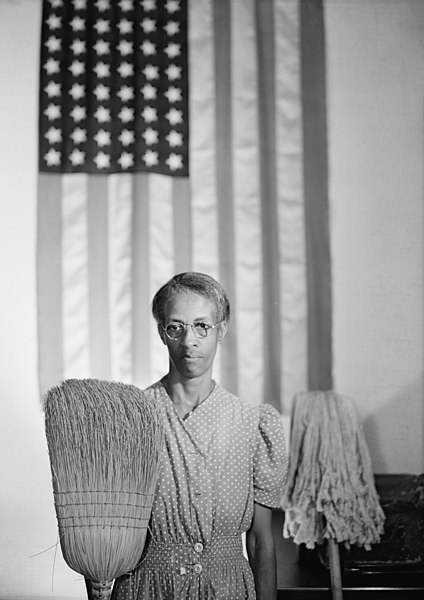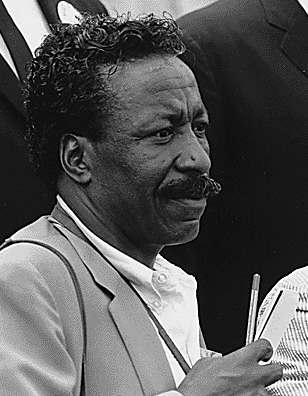.

A Harlem resident, New York, New York, May 1943

Three boys who live in the Harlem area, New York, New York, May-June 1943

Harlem newsboy, New York, New York, May 1943

Harlem newsboy, New York, New York, May 1943

A Harlem street scene, New York, New York, May 1943

A Harlem scene, New York, New York, May-June 1943

Many
accidents are attributed to unpatrolled intersections in Harlem: here
school children are allowed to run across busy intersections unescorted,
New York, New York, May-June 1943

A sign in the Harlem section, New York, New York, May 1943

A woman and her dog in the Harlem section, New York, New York, May 1943

Duke Ellington at the Hurricane Club, New York, New York, May 1943

Duke Ellington at the Hurricane Club, New York, New York, May 1943

Mrs. Ella Watson, a government charwoman, with three grandchildren and her adopted daughter (to right, reflected in mirror), Washington, D.C, August 1942

American Gothic: Mrs. Ella Watson, a government charwoman, Washington, D.C., August 1942

Three youngsters, Frederick Douglass housing project, Anacostia, D.C., June 1942

Government truck, Washington, D.C., August 1942

Construction workman, Washington, D.C., June 1942

Construction workman, Washington, D.C., June 1942

A mother getting the children ready for a neighborhood birthday party, Washington, D.C., June 1942

Paul Robeson singing at Russian war anniversary benefit at the Watergate, Washington, D.C., June 1942

Physical education class, Bethune-Cookman College, Daytona Beach, Florida, February 1943

Sorting mail, Bethune-Cookman College, Daytona Beach, Florida, February 1943

Radio technicians' class, Bethune-Cookman College, Daytona Beach, Florida, February 1943

Students using microscopes, Bethune-Cookman College, Daytona Beach, Florida, February 1943

Students in the home economics class, Bethune-Cookman College, Daytona Beach, Florida, February 1943

Students entering classes, Bethune-Cookman College, Daytona Beach, Florida, February 1943

A student, Bethune-Cookman College, Daytona Beach, Florida, February 1943

Orange picker's daughter, Daytona Beach, Florida, February 1943

Street scene, Daytona Beach, Florida, February 1943

Street scene, Daytona Beach, Florida, February 1943

Street scene, Daytona Beach, Florida, January 1943

Street scene, Daytona Beach, Florida, February 1943

Street scene, Daytona Beach, Florida, February 1943

Street scene, Daytona Beach, Florida, February 1943

Street scene, Daytona Beach, Florida, February 1943

Negro church, Daytona Beach, Florida, February 1943

Street scene, Daytona Beach, Florida, February 1943

Negro laborer, Daytona Beach, Florida, January 1943

Negro apartment house, Jacksonville, Florida, February 1943

Trainman signalling a "Jim Crow" coach, Saint Augustine, Florida, January 1943

[Gordon Parks, Farm Security Administration/Office of
War Information photographer, standing in office with Helen Wool seated
at desk]: photographer unknown, c. 1943
Gordon Parks at the Civil Rights March on Washington, 1963: photographer unknown; file originally created by Steve Hopson, 8 March 2006; cropped image by Ayapota, 15 August 2008 (Still Picture Records Section, Special Media Archives Services Division, National Archives)
Gordon Parks (1912-2006) photos from Farm Security Administration Collection, Library of Congress




12 comments:
Fantastic to greet the day with this remarkable collection, a feast for the eyes and mind, and then to reacquaint myself with the facts of Parks's biography. To be an artist really means to have and diligently express a point of view, a particular vision, and to try to hone it as finely as possible. These are all terrific photos and I love the office portrait of Parks also. I would be so pleased if I could express my own "another America" half as well as Parks expressed his. Curtis
Thanks very much Curtis.
Parks talked a bit about his FSA work with Richard K. Doud when Doud was attempting to reconstruct all that largely-lost history, interviewing those of the survivors who were still around and willing.
GORDON PARKS: I think maybe the rural influence in my life helped me in a sense, of knowing how to get close to people and talk to them and get my work done. That might have helped some. I think [FSA photo project director] Roy [Stryker] stirred the interest in me to try and get to know people and get to know all kinds of people better and investigate their ills and their prejudices and their goods and their evil. It was just like a research into the mind of the one you met and in that way I'm sure you felt that you'd grow in a sense and that sometime would be doing some sort of service by recording as much of it as you could with a camera. I don't know that I was any better equipped. I probably . . . in some instances I was, more than probably the white photographers because of an emotional something that probably I was closer to or akin to which has certainly been in my favor since. Some of those Negro stories that I've done for Life and Standard Oil and other places have dealt with poverty, dealt with the emotional aspect of everyday living, because my own life was packed, early life, was packed with so much of it.
RICHARD DOUD: It made you more sensitive, perhaps?
GORDON PARKS: More aware and sensitive about it than most. I don't say that, you know, I was any more sensitive than the rest of the photographers on the FSA, but I certainly had other areas of my own personal problems in rejection and discrimination than any of them did, because I was a Negro and Roy I think taught me to use that disadvantage in an intelligent way instead of striking back with violence any longer, and so I put it into the camera. Meanwhile, I suppose meeting all these people taught me a lot about human beings that I didn't know, inasmuch as when I came to Washington, I practically hated every white face that I saw because of what happened to me. But as I . . . as he showed me around and exposed me to more and more people, I came to realize that, for really the first time in my life, that we must accept people as individuals and it was a great lesson Roy taught me. He charged me with bitterness at first, showed me both sides of the coin, and then let me take my own choice you know and hoping I'm sure that he had over-exposed me to the best part of it. And felt, I suppose, that if I didn't work out all right then he'd done as much as he could have done toward . . . . I think I was sort of a noble experiment for Roy.
Oral history interview with Gordon Parks, 30 December 1964 (Richard K. Doud, Smithsonian Archives of American Art)
Honest and searching comments. I'd be interested in knowing Roy Stryker's thoughts also. Heavens -- he really had a "deep bench" of talent at FSA. Curtis
Curtis, Roy Stryker was that rare kind of boss, the invisible, noninterfering, helpful, protective, guiding force.
He left almost everything to go without saying, in his assignments.
In fact this post was motivated by one of those it-should-go-without-saying moments, though not involving Roy Stryker.
A friend who has for many years been a menial cleaning hand for the state (though his natural calling is music) came back not long ago from a visit to a school in the interior where his daughter had received an MA. The school is a long way from home for her, but as there had been scholarship money at BA and then again at MA levels, she had diligently (the apt word you use re. GP) stayed the course. (Parks' Bethune-Cookman photos come to mind in this context.)
We had been discussing the Trayvon Martin matter, my friend the cleaning man and I.
I told him he should be relieved that, with the MA, his daughter might be able, at least to some extent, to escape some of the discrimination problems, the profiling.
My friend is a congenial man, but at this point his face became grave, his eyes narrowed, and he said, When you are walking down the street and black, it doesn't matter how many degrees you have. Anything can happen.
And that should have gone without his having to say it, I thought to myself.
And I did then discover that though his photos from Harlem and DC are known, Gordon Parks' work in Florida
has gone largely unseen.
Tom,
Such great seen scenes of daily life going on (and by), glimpses of what there is -- and now was. . .
4.1
first grey light in sky above blackness
of ridge, jet passing above pine branch
in foreground, sound of wave in channel
define setting, paper which
did not carry over to
thinking, that recalls what
there is to be, is it
grey rain cloud against plane of ridge,
silver of drops splashing into channel
Gordon Parks comes across as a master of the everyday life.
All your posts, Tom, featuring FSA photographers are, in their own way, a tribute to Roy Stryker. The man was an original, and ahead of his time, yet of the time he lived in. And he did have a "deep bench" as Curtis notes. Esther Bubley was another of the women shooting for Stryker, along with Marion Post Wolcott and Dorothea Lange.
Yes, each of the FSA photographers seemed to have a particular and distinct gift for extracting some special quality from their subjects, each photographer given one cut or slice of the whole field of common experience, of life as lived, in that time, in that place.
By remembering the wondrous Esther Bubley you will have earned yourself a place in FSA heaven, Hazen.
And too there was Marjory Collins...
I love this. So moving to look at each photo.
I gave a little talk on literary blogging (I was asked to do that, and I hardly think of myself as such), and I had everyone look at yours as the ideal. It's always interesting and beautiful.
Nin,
Many thanks, and you're a pretty good blogger yourself.
The anger in Gordon Parks gives the work an energy that awakens the mind, something that happens every million years or so and is always bracing.
i dunno if people just look
more angelic when in black and white or if that particular time wore better diluted with a simple clarity that shows still.
With Russell Lee and Gordon Parks (and..) Roy Stryker gathered up the American Sistine Chapel. Thank you for putting these here.
Best wishes to you, Tom, from one who has long admired your work.
John Martone
gamefaced and John,
True that... and true that.
Great comments, and I'd have thanked you for them earlier had I not been inconveniently run over by a car.
(The scene was not very Sistine Chapel-like alas... and red all over.)
Post a Comment